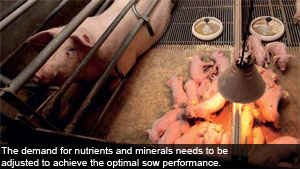Balanced trace element feed improves sow performance

Sow reproductive characteristics and longevity are important for pig farmers to improve their technical and economic results. Nutrition greatly influences these two issues – trace mineral nutrition can especially make a difference in terms of sow puberty and fertility, piglet quality and number of weaned piglets per sow.
By Paul Perucchietti and Wilbert Litjens, Trouw Nutrition Feed Additives, Tilburg, the Netherlands
In modern pig husbandry, the reproductive target for the sow is at 30 weaned piglets per year. Unfortunately, after four to five parities, most sows are replaced or culled because of health problems or reproductive failures. Besides housing and farm management, nutrition is of major influence on the lifetime performance of the sow and her piglets. The body weight of a mature sow can be over 60% of the replacement gilt (210 kg and 130 kg respectively).
Together with a continuous increase in production of piglets and milk (comparable to a high yielding dairy cow per unit of body weight), the demand for nutrients and minerals needs to be adjusted to achieve the optimal sow performance. The feed used for sows is normally the same for all parities at a farm. Vitamin and trace mineral intake relative to the body weight will vary between sows, resulting in an excess or lack of supply. Formulation data combined with feed intake confirms this hypothesis. So it seems most likely that mineral supply could be one of the reasons why sows are replaced after four to five parities. A field trial confirms that feeding vitamins and trace minerals at a constant level relative to body weight does improve the number of piglets weaned at increasing parity.
Reproduction
It is well known that zinc, copper, manganese and selenium play essential roles throughout all parts of the body. Figure 1 shows which trace minerals are essential in pig reproduction. The bioavailability of minerals in the diet directly influences the amount of minerals that the sow can absorb and utilise.
An in vitro study with bovine corpera lutea (CL) showed that the addition of zinc significantly increased the progesterone production by 48%. The addition of luteinic hormone (LH) did not influence the level of progesterone. When adding copper, the progesterone levels significantly increased by 20%. This increase was depending on the presence of LH. Manganese did not influence the progesterone production of CL in vitro. It was concluded that progesterone production depends on zinc and copper availability.
It is clear that a depressed mineral status in older sows depresses the fertility performance. One of the ways to overcome this problem is the use of organic trace minerals. Trouw Nutrition markets Optimin organic minerals, which have the highest pH stability and internal bond strength to ensure an optimal and balanced mineral supply. Several researches have shown that feeding these organic minerals improves sow fertility and piglet performance.
The effect of the product minerals on puberty development and fertility in gilts has been researched. Gilts were fed a control diet or a diet containing these specific organic minerals with a 25% replacement rate.
First of all, gilts fed the product with organic minerals reached the first oestrus 13 days earlier. Furthermore, tissue biopsies revealed that the conceptus from these gilts had higher zinc, copper and manganese concentrations (P<0.01) at the 12th day of gestation. The corpus luteum weight tended to be higher in this group at day 15 (P<0.1). This study shows that an improved bioavailability of essential trace minerals results in improved reproduction characteristics. It is assumed that mineral intake plays a role in hormonal balance, development of the conceptus, implantation and oxygenation of the conceptus.
Sow fertility
Sows of on average 2.3 parities were fed inorganic sources of zinc (120 ppm), manganese (60 ppm) and copper (24 ppm). When replacing 30% of the inorganic minerals with Optimin minerals, this resulted in a significant higher number of pregnancies. At day 30 of gestation the number of live and dead foetuses was determined. The supplementation of the organic minerals resulted in both significant more live (11.3 vs. 13.2) and less dead (2.6 vs. 1.1) foetuses. The levels of zinc, manganese and copper in reproductive tissues were also significantly influenced by the source of the trace minerals.
Another trial showed similar results, in which the new product was top dressed. The basal diet consisted of 125 ppm zinc, 55 ppm manganese and 15 ppm copper. The top dress consisted of 30 mg/d/h zinc, 15 mg/d/h/ manganese and 7.5 mg/d/h copper. There were 898 sows with an average parity of 3.4 involved and which were followed for at least two farrowings. As stated before, a major reason for culling is reproductive failure, the sow returns to oestrus even after several matings. Sows in the group that received the trace minerals showed better reproductive performance which resulted in a significant decrease of the culling percentage (14.0 vs. 8.0). Moreover, both the number of piglets born alive per litter increased (+0.2) as well as the number of piglets weaned (+0.1).
Performance
Many management and nutritional factors influence the performance of sows. One of the nutritional aspects that needs to be considered with increasing parity is the trace element supply. It is shown that providing organic minerals in a more bioavailable form will ensure an optimal mineral supply. This may overcome problems resulting from a lack of essential minerals. By optimising zinc, copper, manganese and selenium levels and source, sow and piglet will be able to perform at a maximum technical level.











